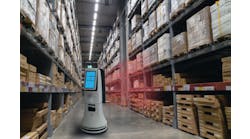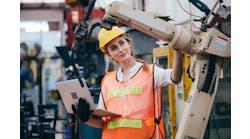By Rick Veague, chief technical officer, North America, IFS
The recent surge in applications of industrial robotics is a direct response to concerns of worker shortages in manufacturing. These machines are adept in the assembly, inspection, and packaging processes that are crucial to warehouse automation and overall resource management.
Consider this example: Cheer Pack, a manufacturer of spouted-pouch packaging, overhauled its operations and significantly cut costs by using six ERP-driven robots. Their Chief Information Officer Alex Ivokovic explained how “Labor shortages have been a pertinent issue for Cheer Pack even before the pandemic and recent skills shortages. Alongside many other manufacturers, we looked to alternative methods to fill the human void.”
This is where robotics came to the rescue.
At Cheer Pack, the robots are not large and super-intelligent humanoids gracing the factory floor. The company designed a robotics strategy to introduce a team of six highly efficient and self-charging small robots to move critical materials around in its warehouse operations at ground level. These floor-level robots take instruction from the company’s enterprise-resource planning (ERP) system to navigate the warehouse and ensure critical materials are available where and when they are required on the manufacturing line.
They might be small, but they deliver—the company has unlocked $1.5 million savings per year thanks to its ERP and robotics integration.
Critical to successes like these is robotic-process automation (RPA), which aims to mitigate latency from the manufacturing process, whether it be guaranteeing the right parts or materials are available at the right time or assigning tasks to best unlock the skills and expertise of operators. When combined, all these elements help organizations exceed consumer expectations and deliver on critical moments of service.
ERP systems provide a behind-the-scenes approach to job scheduling robots
The use of robotics in the manufacturing sector is not an entirely new phenomenon—take robotic welding commonly used in the automotive industry, or common material-handling applications. However, for many manufacturers, automated robots will be a brand-new concept and misconceptions surrounding robots have often acted as a deterrent.
Robots are renowned for operating in real-time and on the manufacturing line. ERP systems on the other hand, take a backseat approach; they work behind the scenes on distributing and scheduling the robots.
The heritage of ERP is process orchestration, and although critical for high-scale business operations, it can be enhanced by robotics and vice versa. RPA is already fulfilling a similar role, with the automation of intelligent business workflows—contrastingly robots are responsible for the automation of intelligent actions. Both must be orchestrated to work together to achieve the desired result, for example, entering the correct product number, order number, or materials required.
Robots can be a value-add to warehouse procedures
Prior to the integration of robotics, labor had been a significant challenge for Cheer Pack and recent economic events have exacerbated existing staffing issues. The story is no different for many other enterprises; the market has propelled into a candidate-driven space. Research from the US Bureau of Labor Statistics has shown that as of March 2022, the number of job openings in the US was at 11.5 million. It is no surprise that countless manufacturing organizations are in search of technology that can fill gaps in human labor and keep pace with growing market pressures.
“Despite already employing a previous ERP system, Cheer Pack recognized that there was potential to add more value to its robotic strategy to carry out warehouse procedures,” added Ivkovic.. “Integrating six robots with Cheer Pack’s existing ERP solution took approximately two months, where just a few challenges over Wi-Fi connectivity and aisle widths became evident. As a result, Cheer Pack was driven to upgrade its existing Wi-Fi system, particularly at low-height levels, and adjusted aisle widths to enable the safe maneuvering of vehicles.”
Enhance but not replace—friendly robots complement human operations
For many years, people have believed in the ethos that robots will replace human activity and be responsible for workers losing their jobs. Cheer Pack is a prime example of how this is certainly not the case—in fact, the robots are designed to work alongside humans, and help with monotonous and repetitive tasks to streamline operations. “Since implementing robots a few years ago, Cheer Pack has been able to redistribute staff into other areas of the business and help find more fulfilling jobs for them to complete. In fact, not one staff member at Cheer Pack has lost their job because of robotic installation,” explained Ivkovic.
The benefits are clear to see. Robotics can drive efficiencies while reducing costs, proven by Cheer Pack realizing annual savings of $1.5 million per year. The robots require zero human entry or interaction, meaning shop orders are sent directly to the ERP system, leaving no room for human mistakes, which in turn will drive compliance, processing times, and the overall customer-experience offering. Unlike humans, robots can work around the clock without getting tired, automatically reducing the risk of error. In fact, the Cheer Pack robots can even take themselves back to a charging bay when they need to take a break, while another is readily available to operate in its place.
As more innovative uses for robots emerge, intelligent operations will only continue to improve in the manufacturing landscape. Artificial intelligence (AI) will become a critical part of this robotic transformation, offering businesses greater visibility through predictive analytics, harnessing the proliferation from IoT (Internet of Things) sensors and actuators across the factory flow. With advanced ERP-enabled robots, manufacturing businesses can make rapid reductions in human-labor issues and unnecessary costs—to keep pace with customer expectations, staff shortages and future-proof operations going forward.


